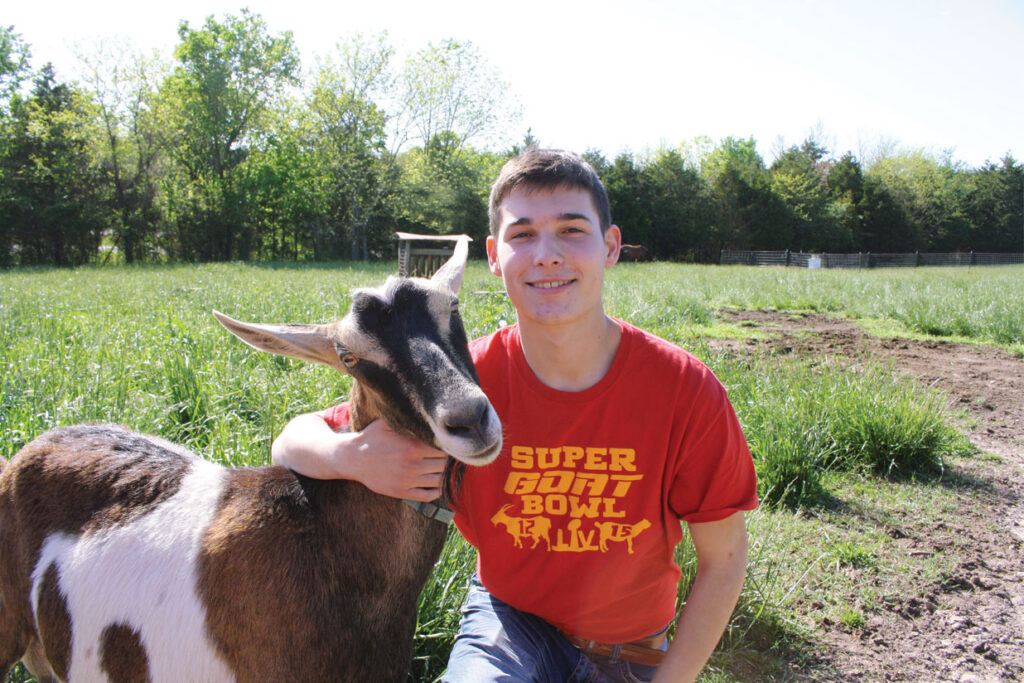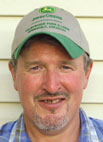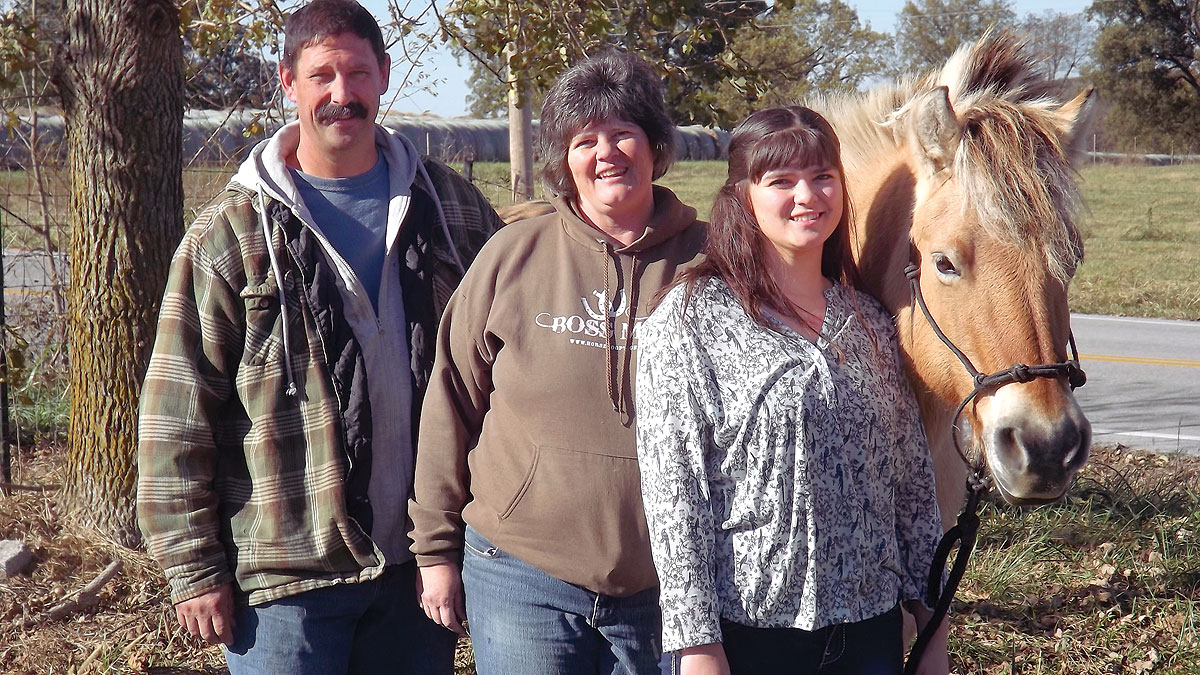
Fair Grove, Mo., teen diligently works to improve his French Alpine herd
Goats have been a part of Devon Miller’s farm life since childhood.
His mom, Elise Miller, has raised meat goats since she 12, but when the Millers began looking at show animals, Devon wasn’t interested in showing meat goats. He gravitated, instead, to dairy goats.
Devon and Elise began looking for dairy goats, specifically Nubians, but every farm they went to, there were also Alpines.
“Alpines became my favorite breed,” Devon said. “I’ve been in dairy goats for about five years now. Alpines have the most personality. They aren’t the sweetest, but when you look in the eye of an Alpine, there’s just something there.”
He opted to go with French Alpines.
“French Alpines can be traced back to the beginning of the breed, back before they closed the herd book in the 1950s. With the American Alpines, a page (from the herd book) was lost, or a goat was bred in that wasn’t a French Alpine,” Devon explained. “Somewhere, something wasn’t complete, so that’s the American Alpine.”
Since venturing into dairy goat production, Devon has sought the best genetics available to build his herd.
“I have some really exciting purchases this year,” Devon, who is 17, said. “Mom and I traveled to Epworth, Iowa, to Pleasant Grove Dairy, which milks 500 to 600 does a day. I picked up a buck kid and a doe kid. I’ve seen a buck from Pleasant Grove, Pleasant Grove Freeze Frame, used in multiple herds, and he is the sire of both my buck and my doe. I need to tighten up my front ends, help out their shoulders and add some width, and I’ve seen that in all of his daughters. I’ve seen some nicely set front legs, right under the withers as they should be, and some nice, smoothly extended briskets in all of his daughters. I figured the best way to do that was to get a son out of him.”
In addition to Pleasant Grove genetics, Devon also has genetics lines tracing to Iron Rod Alpines in Virginia and the P-J Bailey herd in Ohio.
Devon depends on his herd bucks for breeding, but he also has more than 100 straws of semen he has purchased from various bucks.
“I can look at my doe and say, ‘I really like this, but I want to fix this,’” Devon explained. “With my extensive catalog of buck options, I can pick what is going to be the best. I have some plans to do some AI this fall. I got an AI kit for Christmas, which some may think is a strange gift, but I was excited.”
In early January, the family, which also includes Devon’s dad Nathan and younger sister Alyssia, kidded about 30 does, producing more than 50 kids. At the height of their milk production, 21 does, including mom Elise’s Nubians, were being milked twice a day. Today, 10 does are currently milked in their more than 100-year-old barn, which was once used for dairy cattle.
The majority of the milk goes back to the kids, but there is still enough milk for the Miller family’s use and a couple of milk customers.
Ideally, females will kid from the end of January through early February.
“That’s when we start milking,” Devon explained. “The standard lactation of a dairy goat is 10 months. With my first fresheners, they produce about 6 to 8 pounds of milk, so just under a gallon. On my older does, they will go 10 to 12 pounds, occasionally up to 14 pounds. Sixteen pounds is 2 gallons, so not too bad.”
Devon said when the family was milking 21, more than 20 gallons of milk was bring produced daily.
Devon is particular about the quality of kids sold to other producers.
“I’m very strict the buck kids that can leave with my name,” he said. “It has to be out of quality doe and a buck that I would use on my herd. The qualifications are strict, and if they aren’t met, the buck is wethered and sold as a pet or for meat. With the doe kids, I am picky about what I kept. Does will be sold as registered does and go to other show herds that and raise them to their best potential.”
There are many misconceptions about goats, the biggest being that they will eat anything.
“Goats are the most finicky species of livestock to raise,” he said. “If you want a doe that is going to produce, you have to be very strict nutritionally. If you want a doe that will produce, you are going to have to spend some money on good-quality feed.”
Because nutrition is critical for milk production, goats receive high-protein alfalfa hay and plenty of clean water.
“Alfalfa is a go-to, and it helps you keep your production up all year long, not just in the winter. We like for our goats to be goats, so they do forage as well,” Devon said. “A lot of people who have show herds leave them in the barn with alfalfa hay; that’s all they get. Ours are on 10 acres to forage in addition to free-choice alfalfa, and we also have a free-choice mineral out all year that seems to help keep their coat shiny. Whole oats is another thing, and we mix that in their feed.”
Proper nutrition is a critical part of producing quality animals and animal products, but there has to be a foundation.
“You have to start with high-quality genetics,” Devon said. “You can feed the best feed to a doe that has mediocre genetics, and you are never going to get the same production as a top-quality genetic doe.”
Health protocols include regular fecal samples, which are performed on the farm by the Millers.
“If we see an animal that is a little run down, we can run a fecal and see what parasite we are dealing with, and treat it with the exact medication needed,” Devon explained, adding that dewormer resistance is a big problem in goat production. “Everyone, for a long time, just wormed on a schedule if they were showing signs or not, or they weren’t giving doses large enough to kill the ones in the system. Now you basically have super worms that it takes harsh stuff to kill.”
Goats receive CDT vaccinations annually to protect against Clostridium perfringens type C and D (overeating disease) and Clostridium tetani (tetanus). Adults receive a booster once a year, while kids are vaccinated at 2 months of age, followed by a booster two weeks later.
The initial move to the French Alpine breed was for show animals and the family continues to show at American Dairy Goat Association-sanctioned shows. Wins at those shows are credited to the animal and become part of its pedigree.
“Shows prove the work you are doing is paying off,” he said.
Devon typically shows at the Ozark Empire Fair, the Missouri State Fair, and other shows, including quad and six-ring shows. Those shows, Devon explained, have multiple rings, with a judge in each.
“In a normal show, there is one ring and one judge, and that is the entire show,” he said. “With the six-ring show, there are six rings and six judges in two days. Last year, we took our two senior bucks, and my Bailey buck won two championship legs, and it takes three to become a permanent champion. My younger buck was switching places with the breeder he came from and one of her bucks. It was funny to watch one judge place her above me; then the next judge place me over her in the next ring. It makes you excited to go out and consistently place well in front of six judges.”
Kids born from his two-time champion buck will have a greater value, Devon ex-plained, because of his wins in the ring. Devon added that he hopes the buck will get his third championship this spring.
This year’s national American Goat Society show will be held in Sedalia, Mo., and Devon hopes to take animals to that June event.
Devon’s dedication to the improvement of his French Alpine herd has caught some attention. He received the Missouri FFA Association Goat Production in April. With his state win, Devon is eligible to compete for the national award.
“My advisor, Matt Crutcher, said I had enough points, and I had a solid application,” Devon said, adding that high school juniors don’t typically apply for a state award. “I remember going up on the stage (at the Missouri State FFA Convention), and they handed me my plaque. I looked at it, and it said ‘State Winner.’ I thought, ‘Well, this is a little exciting.’”
The state-level award culminated his work in dairy goat production, but he said it wasn’t always easy.
“This hasn’t come without hard work,” Devon said, adding he has recently sold some of his older foundation does, and his two older bucks will also be going to new herds in the future. “I had to prove to my mom that this is what I want to do.”
Devon isn’t sure what the future holds for his herd, but he hopes to continue to develop the best genetics possible.
“In a perfect world, I would keep my goats all through college. I want to attend nationals and maybe win a national championship with one of my does. I would eventually like to get to the point where I’m selling top-quality genetics around the country, just like those herdsI follow on Facebook; that’s my end goal. I’m not going to live with Mom and Dad forever, and I don’t know if I will be able to afford a farm after I graduate from college. I would like to know, for certainty, that I would have a place for my goats so that I can continue this project. Right now, everything is a big question mark.”








